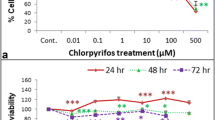Abstract
The synthetic organophosphate insecticide, quinalphos is used widely due to its insecticidal and acaricidal properties. However, toxicity of quinalphos has not been well elucidated despite the increasing quinalphos ingestion cases worldwide. Our study emphasizes on the cytotoxic effect of quinalphos on human alveolar A549 cells. Quinalphos reduced cell viability, induced lactase dehydrogenase (LDH) release and intracellular reactive oxygen species (ROS) generation. DNA condensation and prominent apoptosis were detected in quinalphos-treated cells through cytochrome c release from mitochondria to cytoplasm, and cleavage of caspase-3 and -9. Investigation of the effect of quinalphos on the expression of antioxidant- and apoptosis-related genes showed that most of the antioxidant genes were down-regulated, while apoptotic genes were up-regulated. Therefore, we propose that the toxicity of quinalphos is mediated by increasing generation of ROS, modulation of expression of major antioxidant genes that have considerable role in mitigating oxidative stress, and the induction of apoptosis.
Similar content being viewed by others
References
Peter, J. V. & John, G. Management of acute organophosphorus pesticide poisoning. Lancet 371: 597–607 (2008).
Gupta, B., Rani, M., Salunke, R. & Kumar, R. In vitro and in vivo studies on degradation of quinalphos in rats. J Hazard Mater 213–214: 285–291 (2012).
Pimentel, D. Amounts of pesticides reaching target pests: Environmental impacts and ethics. J Agr Environ Ethics 8: 17–29 (1995).
Pant, N. & Srivastava, S. P. Testicular and spermatotoxic effects of quinalphos in rats. J Appl Toxicol 23: 271–274 (2003).
Rahman, M. F., Mahboob, M. & Grover, P. Comparative sensitivities of in vitro acetylcholinesterase inhibition by novel organophosphorus compounds in broiler chicken. Toxicol Int 11: 49–53 (2004).
Teixeira, H. et al. Pesticide intoxications in the Centre of Portugal: three years analysis. Forensic Sci Int 143: 199–204 (2004).
Ellenhorn, M. J. in Diagnosis and Treatment of Human Poisoning (eds Schonwald, S., Ordog, G., Wasserberger, J.) 1614–1663 (Ellenhorn’s Medical Toxicology, Williams & Wilkins, Maryland, 1997).
Sarkar, R., Mohanakumar, K. P. & Chowdhury, M. Effects of an organophosphate pesticide, quinalphos, on the hypothalamo-pituitary-gonadal axis in adult male rats. J Reprod Fertil 118: 29–38 (2000).
Mandal, T. K. & Das, N. S. Quinalphos induced oxidative stress and histoarchitectural alteration in rat testis. Toxicol Int 11: 93–102 (2004).
Das, B. K. & Mukherjee, S. C. Chronic toxic effects of quinalphos on some biochemical parameters in Labeo rohita (Ham.). Toxicol Lett 114: 11–18 (2000).
Riediger, S. et al. Toxicity of the quinalphos metabolite 2-hydroxyquinoxaline: growth inhibition, induction of oxidative stress, and genotoxicity in test organisms. Environ Toxicol 22: 33–43 (2007).
Teixeira, H. et al. Pesticide intoxications in the centre of Portugal: three years analysis. Forensic Sci Int 143: 199–204 (2004).
Sarkar, R., Mohanakumar, K. P. & Chowdhury, M. Effects of an organophosphate pesticide, quinalphos, on the hypothalamo-pituitary-gonadal axis in adult male rat. J Reprod Fertil 118: 29–38 (2000).
Vairamuthu, S. & Thanikachalam, M. The effect of quinalphos on blood and brain esterase activity in chicken. Indian Vet J 80: 1160–1163 (2003).
Srivastava, M. K., Raizada, R. B. & Dikshith, T. S. S. Fetotoxic response of technical Quinalphos in rats. Vet Hum Toxicol 34: 131–133 (1992).
Dikshith, T. S. S. & Datta, K. K. & Raizada, R. B. Effect of repeated oral administration of quinalphos to male goat (Carpa hircus). J Biosci 4: 405–411 (1982).
Rupa, D. S., Reddy, P. P. & Reddy, O. S. Cytogenetic effects of quinalphos in mice. Food Chem Toxicol 29: 115–117 (1991).
Pongrac, I., Roglić, M., Sever, B. & Popek, B. Cytomorphologic changes in bronchial epithelial cells in a patient exposed to an aerosol of the organophosphorus insecticide, Ekalux 25 (quinalphos), 0,0-diethyl-0-quinoxaline-2-phosphorothioate. Plucne Bolesti 41: 39–41 (1989).
Dwivedi, P. D., Das, M. & Khanna, S. K. Role of Cytochrome P-450 in quinalphos toxicity: effect on hepatic and brain antioxidant enzymes in rats. Food Chem Toxicol 36: 437–444 (1998).
Abdollahi, M., Ranjbar, A., Shadnia, S., Nikfar, S. & Rezaie, A. Pesticides and oxidative stress: a review. Med Sci Monit 10: RA141–RA147 (2004).
Subramaneyaan, M. et al. Quinalphos induced oxidative stress and histoarcheitectural alterations in adult male albino rats. Environ Toxicol Pharmacol 34: 673–678 (2012).
Riediger, S. et al. Toxicity of quinalphos metabolite 2-hydroxyquinoxaline: growth inhibition, induction of oxidative stress and genotoxicity in test organisms. Environ Toxicol 22: 33–43 (2007).
Gupta, B., Rani, M., Kumar, R. & Dureja, P. Decay profile and metabolic pathways of quinalphos in water, soil and plants. Chemosphere 85: 710–716 (2011).
Jones, D. P. Redefining oxidative stress. Antioxid Redox Signal 8: 1865–1879 (2006).
Jones, D. P. Radical-free biology of oxidative stress. Am J Physiol Cell Physiol 295: C849–C868 (2008).
Zerin, T., Kim, Y. S., Hong, S. Y. & Song, H. Y. Protective effect of methylprednisolone on paraquat-induced A549 cell cytotoxicity via induction of efflux transporter, P-glycoprotein expression. Toxicol Lett 208: 101–107 (2012).
Kim, Y. S., Zerin, T. & Song, H. Y. Antioxidant Action of Ellagic Acid Ameliorates Paraquat-Induced A549 Cytotoxicity. Biol Pharm Bull 36: 609–615 (2013).
Author information
Authors and Affiliations
Corresponding author
Rights and permissions
About this article
Cite this article
Zerin, T., Song, HY. & Kim, YS. Quinalphos induced intracellular ROS generation and apoptosis in human alveolar A549 cells. Mol. Cell. Toxicol. 11, 61–69 (2015). https://doi.org/10.1007/s13273-015-0008-4
Received:
Accepted:
Published:
Issue Date:
DOI: https://doi.org/10.1007/s13273-015-0008-4




